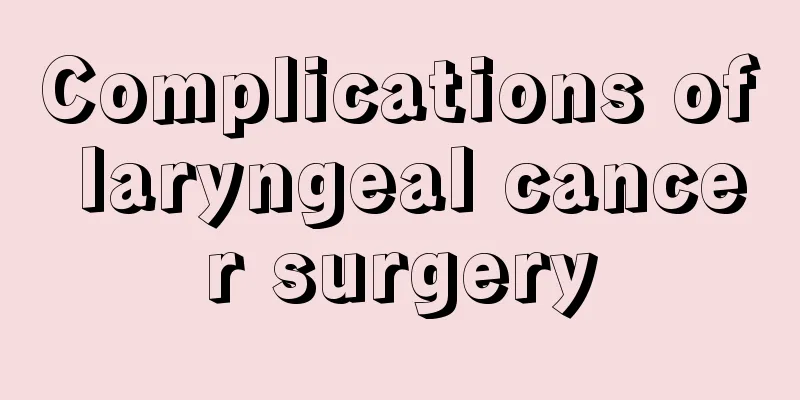Complications of laryngeal cancer surgery

|
Surgery is the main and effective means of treating laryngeal cancer, and it has unparalleled advantages over other treatment methods. The surgical methods for laryngeal cancer are mainly divided into total laryngectomy and partial laryngectomy. Due to the understanding of the embryology, anatomy, pathology of the larynx, the biological behavior of laryngeal cancer, and the continuous improvement and maturity of laryngeal function repair technology in recent years, partial laryngectomy has developed rapidly and has become the dominant surgical treatment method for laryngeal cancer. Compared with total laryngeal surgery, the indications have gradually narrowed, but for patients with advanced cancer, recurrence after partial laryngectomy, recurrence after radiotherapy, the elderly and weak, and those with poor economic conditions, total laryngectomy is still a reliable treatment method. The main complications of surgery are: 1. Bleeding Cause: Mainly due to incomplete hemostasis of the wound and loose blood vessel ligation. Prevention and treatment: A small amount of bleeding generally does not require treatment. If the amount of bleeding is large, the surgical wound needs to be reopened to find the bleeding point and ligate it. Especially for bleeding from the superior laryngeal artery and the isthmus of the thyroid gland, it must not be neglected, otherwise it will cause a large amount of bleeding and a neck hematoma, which will compress the trachea, cause breathing difficulties, and even serious consequences such as body weight. 2. Local infection in the surgical area Reason: Because it is a contaminated surgery, wound infection is still difficult to completely avoid. Prevention and treatment: Pay attention to protecting the wound surface and preventing contamination. After closing the pharyngeal mucosa, the surgical cavity should be fully rinsed. If necessary, antibiotic solution should be injected. When suturing the muscle layer and skin, no dead space should be left. Drainage strips can be placed. Strengthen anti-infection measures after surgery, supplement nutrition, and promote early healing of the wound. If a deep neck abscess has formed, perform incision and drainage according to the principle of surgical incision and drainage. If the mediastinal abscess is confined to the upper mediastinum, an incision can be made along the inner side of the sternocleidomastoid muscle for drainage; if it is in a lower position, X-ray positioning must be used, part of the corresponding ribs must be removed, the pleura is pushed open, and the posterior mediastinum is drained. 3. Lung infection Pulmonary infection is a common perioperative complication in elderly patients, with a reported incidence of 35 to 50 percent. Causes: Long-term smoking and physiological reasons of the elderly can weaken the movement of respiratory epithelial cilia, making it difficult for secretions in the trachea to be discharged and easy to be retained. Postoperative secondary lung infection is easy, and tracheotomy also increases the chance of infection. Improper care of the indwelling gastric tube will lead to reflux of gastric juice and aspiration. Patients lying flat can easily cause oral secretions to be aspirated into the trachea. Aspiration is a risk factor for lung infection. Prevention and treatment: Prevention of lung infection: ①Do a good job of publicity before surgery, persuade them to quit smoking, and those with respiratory tract infection should have surgery after the infection is controlled. Observe body temperature and lung signs after surgery, encourage early bed activities, which is conducive to recovery and coughing up lung secretions, and reduce the chance of lung infection. ②Do a good job of respiratory management, clear tracheal secretions in time, keep the respiratory tract unobstructed, pay attention to airway humidification, nebulize inhalation once every 6 hours, drip humidifying liquid into the trachea 5-10ml/h, and strengthen physical therapy at the same time. ③To prevent aspiration, raise the head 30 degrees to lie down after surgery, and give a semi-recumbent position for at least 1 hour when nasogastric feeding. When patients eat by mouth in the early stage, they should eat paste or sticky food, and pay attention to the body position when eating, which can effectively reduce accidental swallowing. ④For patients suspected of lung infection, take respiratory secretions for bacterial culture and drug sensitivity, and give sensitive antibiotics. In order to better prevent postoperative complications, it is recommended to use ginsenoside Rh2 as an auxiliary treatment, which has a good effect on postoperative prognosis. |
<<: How to check and diagnose the early symptoms of laryngeal cancer
>>: Can laryngeal cancer be transmitted through the blood?
Recommend
How long does it take for pseudo-condyloma to subside
Many diseases are both real and false. Why do we ...
What is a normal pulse rate during exercise
Nowadays, exercise has become a very effective wa...
What exactly is prostate cancer?
Prostate cancer is a disease that can make men co...
What medicine should I take if my heart stops working
Cardiac arrest seems very unfamiliar to many peop...
Why do I always feel bloated at night?
Abdominal bloating is a relatively common symptom...
How long can lung cancer patients live? Lung cancer patients should remember four points to live longer
After being diagnosed with central lung cancer, m...
The reason why I always feel hungry
Some of you may always feel hungry in your life. ...
Will there be recurrence after radiotherapy
After getting cancer, the first thing that comes ...
The efficacy and function of pigeon eggs
When it comes to the efficacy and functions of pi...
Pure sweet potato vermicelli
Sweet potato vermicelli is also called sweet pota...
Can tea stems remove formaldehyde?
Many people are concerned about the harm of forma...
What are the nursing measures for breast cancer
What are the nursing measures for breast cancer? ...
How much does a brain cancer check cost
The issue of hospital examinations and drug charg...
How to keep shrimp fresh in the refrigerator
Mud shrimp is a commercial name, also known as mu...
What are the cold fruits
Maybe many of us have a special liking for cold f...









